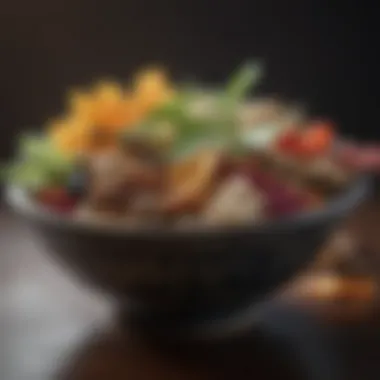Enhancing Circulation with Chinese Herbs: A Detailed Study


Overview of Research Topic
Brief Background and Context
In recent decades, interest in the role of traditional medicine in health promotion has surged. Among these approaches, Chinese herbal medicine is particularly notable for its historical significance and its continued relevance today. Chinese herbs have been employed for centuries to enhance circulation, a vital process for maintaining overall health. Blood flow influences many bodily functions, ranging from nutrient delivery to waste removal. The historical texts of Traditional Chinese Medicine (TCM) reference multiple herbs believed to tonify or invigorate blood circulation.
Importance in Current Scientific Landscape
Contemporary research now investigates these claims under scientific scrutiny. This intersection of ancient practices and modern science reveals a wealth of information about the biochemical mechanisms behind these herbs. Furthermore, understanding how these herbs influence circulation can be pivotal in addressing cardiovascular issues prevalent in modern society. Conditions such as hypertension and varicose veins highlight the significance of effective circulation. The increased interest from both researchers and the public contributes to the legitimacy of these natural remedies in the eyes of the medical community.
Methodology
Research Design and Approach
A systematic review approach is employed to compile existing scientific literature regarding Chinese herbs and their effects on circulation. This includes a wide range of studies, clinical trials, and meta-analyses that provide insights into the efficacy and mechanisms of these herbs. By aggregating findings from various sources, a comprehensive picture of current knowledge is developed.
Data Collection Techniques
Data collection involved sourcing studies from databases such as PubMed, Scopus, and Google Scholar. Keywords used include "Chinese herbs," "circulation," "vascular health," and "traditional medicine." Each identified study underwent a thorough review to assess its relevance and reliability, ensuring that the final selection was both pertinent and scientifically robust. The rigorous approach aims to lay a solid foundation for understanding how traditional knowledge can be integrated into contemporary healthcare practices.
Intro to Chinese Herbs and Circulation
Understanding the role of Chinese herbs in circulation is paramount for those exploring the intersections of traditional medicine and modern health practices. These herbs have been utilized for centuries, providing a natural method to enhance blood flow and improve overall vascular health. The significance of this topic extends beyond mere historical context; it encompasses contemporary applications and the potential benefits that these remedies can offer to various populations.
Chinese herbs have a distinct approach to health, where circulation does not solely refer to blood flow but is intricately linked with the body’s entire energy system. Recognizing this perspective is essential for appreciating how these herbs work. They are often categorized based on their properties and functions, leading to nuanced applications in health.
Key Elements to Explore
- Benefits: The improvement of circulation can lead to better organ function, increased energy levels, and enhanced recovery from physical exertion.
- Considerations: It is crucial to understand the quality and preparation of these herbs, as well as any interactions they may have with prescribed medications.
- Integration: The relevance of this topic lies in its potential to enrich modern medicine by introducing effective herbal solutions that may complement or even improve conventional treatments.
In this article, we aim to dissect various elements surrounding the use of Chinese herbs in the context of circulatory health, laying a foundation for both understanding their historical significance and exploring their modern-day applications.
Mechanisms of Action
Understanding the mechanisms of action of Chinese herbs in relation to circulation is essential. This section reveals how specific bioactive compounds interact with biological systems to enhance blood flow and support overall vascular health. By examining these processes, we gain insights into the efficacy and safety of these traditional remedies in modern contexts.
Bioactive Compounds in Chinese Herbs
Chinese herbs contain various bioactive compounds that contribute to circulatory health. These include flavonoids, terpenoids, and alkaloids. Each compound plays a unique role in influencing vascular function.
- Flavonoids: These compounds are known for their antioxidant properties. They can improve endothelial function, which is crucial for maintaining vascular health. They may also reduce inflammation and promote vasodilation, thereby enhancing blood flow.
- Terpenoids: Found in many herbs, terpenoids support circulatory health by improving blood vessel flexibility. They help in modulating blood pressure and can reduce the risk of clot formation.
- Alkaloids: Many alkaloids possess significant physiological effects. They can stimulate blood circulation and thus are critical in treating conditions related to poor blood flow. By understanding these compounds, one can appreciate the medicinal potential that lies within traditional practices.
Effects on Blood Flow and Vascular Health
The positive effects of Chinese herbs on blood flow and vascular health are well-documented. Evidence suggests that these herbs can enhance circulation through multiple pathways.
- Increased Nitric Oxide Production: Certain herbs stimulate the endothelial cells to produce nitric oxide, a key molecule that promotes vasodilation and increases blood flow.
- Reduction of Blood Viscosity: Some herbs can lower blood viscosity. This leads to less resistance in blood flow, making it easier for blood to circulate efficiently throughout the body.
- Anti-inflammatory Effects: Reducing inflammation is vital for vascular health. Chronic inflammation can lead to atherosclerosis. Chinese herbs' anti-inflammatory properties contribute to healthier blood vessels and improved overall circulation.
- Enhanced Cardiac Function: Many Chinese herbs support heart health. By improving cardiac output, these herbs can significantly benefit overall circulation.


"The intricate interplay between bioactive compounds and circulatory dynamics underscores the therapeutic potential embedded in Chinese herbal medicine."
Key Chinese Herbs for Circulatory Health
Understanding the significance of Chinese herbs in promoting circulatory health is essential for integrating traditional medicine with contemporary practices. These herbs have a long history of use, often revered for their unique properties that potentially address various cardiovascular concerns. They interact with blood circulation mechanisms, sometimes enhancing blood flow, improving vascular health, and even influencing other body systems like the immune system.
Research indicates that specific herbs contain bioactive compounds, such as flavonoids and terpenes, which may influence vascular function. By improving circulation, these herbs can benefit not just individuals with chronic conditions but may also support healthy adults in maintaining optimal vascular health.
As we delve into the realm of key Chinese herbs, it becomes crucial to evaluate their profiles comprehensively. This includes understanding their historical uses, scientifically backed benefits, possible side effects, and the implications of integrating these herbs into daily routines or medical practices.
Ginkgo Biloba: Beyond the Myths
Ginkgo Biloba is perhaps one of the most researched herbs in the context of circulation. Known for its fan-shaped leaves, it is believed to enhance blood flow, especially to the brain. The active constituents, including flavonoids and terpenoids, provide antioxidant properties, which may protect blood vessels from damage. Studies have shown that Ginkgo Biloba can improve memory and cognitive function, possibly by increasing blood circulation to the brain.
However, while Ginkgo is widely regarded as beneficial, it is essential to approach its use critically. Individuals taking blood thinners should consult healthcare professionals due to the potential for increased bleeding risk. It’s important to dispel myths surrounding Ginkgo's effectiveness, basing decisions on scientific evidence rather than anecdotal reports.
Dong Quai: A Traditional Remedy
Dong Quai, often referred to as "female ginseng," holds a significant place in traditional Chinese medicine. This root is known for its ability to nourish and invigorate the blood. It is thought to influence hormone balance and is often used to alleviate menstrual discomfort and enhance reproductive health. Its active compounds, like ligustilide, can promote circulation by relaxing blood vessels.
While it is generally well-tolerated, Dong Quai may not be suitable for everyone. Individuals with hormone-sensitive conditions should seek advice before using it. Further investigations are warranted to clarify its roles in circulation and overall health.
Red Clover: The Modern Perspective
Red Clover has recently gained attention in the health community for its potential benefits in circulatory health. It contains isoflavones, which can mimic estrogen in the body, possibly offering benefits during menopause. The herb is often praised for its ability to improve cardiovascular health by supporting healthy cholesterol levels and promoting healthy blood flow.
Contemporary research has started to validate some of these benefits. However, like many herbs, it may present interactions with various medications, particularly blood thinners. Its use requires careful consideration and professional guidance to maximize benefits and minimize risks.
Cordyceps: Enhancing Athletic Performance
Cordyceps is a fungus known for its ability to enhance physical performance and energy levels. This herb is believed to improve oxygen utilization and enhancing energy production in cells. Its reputation as a natural ergogenic aid is supported by some studies suggesting that Cordyceps could increase exercise performance and endurance by improving circulation.
While Cordyceps is generally considered safe, evidence regarding its efficacy vary. Individuals interested in using it as a supplement for performance enhancement should proceed with caution and ideally consult with health professionals.
"The integration of traditional knowledge with scientific scrutiny can unlock the potential benefits of these herbs in enabling better health practices."
In summary, exploring key Chinese herbs like Ginkgo Biloba, Dong Quai, Red Clover, and Cordyceps offers valuable insights into how they may enhance circulatory health. Understanding their mechanisms, benefits, and considerations allows for a more informed approach to herbal use.
Contemporary Applications
Contemporary applications of Chinese herbs in circulation extend traditional practices into modern medical frameworks. The integration of these herbs into current healthcare systems offers promising benefits, informed by historical uses and substantiated through scientific investigation. As interest in alternative and complementary medicine grows, understanding how these herbs fit into today’s medical landscape becomes essential. This section explores significant elements such as current methodologies, integration processes, benefits observed, as well as considerations necessary for effective application in clinical settings.
Integrating Chinese Herbs into Modern Medicine
The process of integrating Chinese herbs into modern medicine is multifaceted, requiring both scientific validation and clinical acceptance. Many healthcare professionals now recognize the potential of these herbs to enhance patient outcomes. For instance, combining traditional herbal remedies with conventional treatments may increase efficacy for certain conditions.
Researchers often conduct thorough evaluations to determine the safety and effectiveness of various herbs. Regulatory bodies, while slow to recognize herbal medicine, increasingly support the integration of these practices, provided they meet rigorous scientific standards.
- Protocols for Implementation: These may involve herbal extracts in conjunction with pharmaceuticals for chronic illnesses such as cardiovascular disease. Protocols must be well-defined to ensure dosage safety and minimize risks of interactions.
- Training for Practitioners: Holistic training for practitioners is essential, so they can recommend appropriate Chinese herbs while monitoring patient reactions closely.
- Patient Education: Informing patients about the role of herbs and their benefits empowers them to make informed decisions.


Integrating these herbs requires continuous evaluation and adaptation to ensure they align with modern medical practices.
Case Studies and Clinical Trials
Clinical trials spotlight key findings regarding the efficacy of Chinese herbs in enhancing circulation. For example, a randomized controlled trial examined the effects of Ginkgo biloba on patients with intermittent claudication. Results indicated significant improvements in pain-free walking distance compared to a placebo group. These findings bolster the argument for integrating Ginkgo biloba as a supportive treatment in circulatory health.
Several other significant case studies warrant attention:
- Dong Quai Trial: A study demonstrated that Dong Quai improved blood circulation parameters among women experiencing menstrual irregularities.
- Cordyceps Research: Ongoing trials assess Cordyceps in enhancing athletic performance and improving recovery times in athletes, indirectly benefiting overall circulatory health.
- Red Clover Investigations: Observational studies indicate a potential role of Red Clover in managing menopausal symptoms, with implications for vascular health when utilized over time.
As these case studies and trials unfold, they provide a clearer picture of the effectiveness of Chinese herbs. Such data becomes instrumental in future dietary recommendations and therapeutic guidelines.
"The harmonization of Chinese herbs with modern medical practices illustrates a growing movement toward integrative health solutions, emphasizing the importance of clinical validation."
Continued research will be key in determining how these herbs can best be utilized, offering insights not only for practitioners but also for patients seeking holistic approaches to their health.
Potential Risks and Side Effects
Understanding the potential risks and side effects associated with Chinese herbs is crucial for anyone considering their use for circulatory health. As with any medicinal approach, particularly those that integrate traditional and modern practices, awareness of possible adverse effects and interactions will inform safer usage.
Herb-Drug Interactions
One significant concern in the use of Chinese herbs relates to herb-drug interactions. Many individuals are under prescriptions for various health conditions, and the addition of herbs can complicate their treatment plan. For example, herbs like Ginkgo Biloba may enhance blood thinning effects when taken alongside anticoagulants such as Warfarin. This interaction can lead to increased risk of bleeding, which might not be immediately evident until serious complications arise.
- Potential Interactions Include:
- Ginkgo Biloba: May amplify the effects of blood thinners.
- Dong Quai: Has estrogenic properties that can interfere with hormone medications.
- Red Clover: May affect the metabolism of certain drugs like Tamoxifen.
Regular monitoring and consulting healthcare professionals is necessary to minimize risks. Patients should disclose all herbal supplementation to their physicians to prevent adverse effects effectively.
Allergic Reactions and Contraindications
Allergic reactions to Chinese herbs can occur, much like any other form of medication. While natural, these herbs contain potent bioactive compounds that may trigger sensitivities in some individuals. It's essential to recognize symptoms of an allergic reaction, which can range from mild skin irritations to severe anaphylactic responses.
- Common Allergens in Chinese Herbs:
- Gingko Biloba: Rarely, some may experience skin rashes or gastrointestinal distress.
- Dong Quai: May cause allergic responses, especially in those with sensitivities to celery or parsley.
- Cordyceps: Some may find they react negatively due to molds or fungi preservatives.
Additionally, certain populations should avoid specific herbs due to contraindications. Pregnant or nursing women, for example, should exercise caution. Herbs such as Red Clover can potentially disrupt hormonal balance during these critical periods. Thus, understanding one's health context is paramount before embarking on a regimen including Chinese herbs.
"Being informed about both the benefits and the risks involved in using Chinese herbs is essential for achieving the desired therapeutic outcomes without unwanted side effects."
The Future of Research on Chinese Herbs
The exploration of Chinese herbs in the context of circulatory health is a field constantly evolving. As global interest in alternative medicine rises, so does the need for rigorous scientific validation of traditional practices. Understanding the potential of Chinese herbs goes beyond historical use; it requires an alignment of traditional wisdom with modern scientific inquiry. This intersection promises a future where empirical data can support the anecdotal benefits attributed to these natural remedies.
Innovations in Ethnopharmacology
Ethnopharmacology is emerging as a critical discipline. This field studies how various cultures use plants for medicinal purposes. The importance of this area cannot be overstated. By utilizing advanced technologies such as genomics and metabolomics, researchers are able to identify active compounds within herbs more accurately.


For example, the compound ginkgolide from Ginkgo Biloba has shown promise in improving blood flow and has been studied extensively for its pharmacological effects. Innovations like high-throughput screening techniques allow scientists to test the effects of these compounds on human cells efficiently, potentially leading to new treatments.
- Benefits of Innovations:
- Enhanced understanding of how herbal compounds interact with human biology.
- Potential for developing standardized herbal medicines that are more effective and reliable.
- Opportunities to create novel therapies based on traditional knowledge.
Research focusing on ethnopharmacology could usher in a new era of botanical medicine, where discoveries lead to treatments grounded in both science and tradition.
Interdisciplinary Studies and Collaborations
The future of research on Chinese herbs also hinges on interdisciplinary collaboration. This involves merging insights from various scientific fields—biology, chemistry, and medicine—with traditional Chinese medicine practices. Such collaborative efforts yield comprehensive insights into how these herbs function at physiological and biochemical levels.
Joint ventures between academic institutions, pharmaceutical companies, and traditional herbalists can facilitate the sharing of knowledge. These partnerships can drive significant progress in understanding efficacy and safety profiles of these herbs.
- Considerations in Collaborations:
- Bridging the gap between the empirical data scientists seek and the experiential knowledge herbalists possess.
- Formulating research agendas that include both placebo-controlled trials and observational studies to provide a fuller picture of therapeutic potential.
- Encouraging regulatory bodies to develop frameworks that accommodate the integration of traditional herbs into modern healthcare.
"Collaborative research can harness the strengths of both ancient herbal practices and cutting-edge science, paving the way for novel therapeutic options."
End
The exploration of Chinese herbs in relation to circulation highlights a fascinating intersection of traditional wisdom and modern science. Throughout this article, the importance of these herbs as natural remedies for circulatory issues has been thoroughly discussed. They offer potential benefits such as improved blood flow, enhanced vascular health, and broader physiological effects that align with the goals of maintaining overall wellness.
Summarizing Benefits and Considerations
The benefits associated with Chinese herbs are numerous. They have been found to contain bioactive compounds that promote circulation and support cardiovascular health. For instance, Ginkgo Biloba may improve blood circulation to the brain, while Dong Quai is often utilized for its blood-nourishing properties in women.
Key points to consider include the balance between traditional practices and scientific validation. With the increasing interest in integrative medicine, understanding how these herbs function at a biochemical level is vital. However, it is equally important to remain cautious.
- Potential Risks: Always consider the possibility of allergic reactions or interactions with other medications. Some herbs, although beneficial, may not be suitable for everyone. Individuals must consult healthcare providers to avoid adverse effects.
- Research Gaps: While much has been learned, the field continues to evolve. Future research should aim to bridge the gap between ethnopharmacology and clinical applications.
Importance of References in This Article
References contribute in the following ways:
- Support Claims: Each assertion about the efficacy of Chinese herbs relies on empirical studies and historical texts. Citing these sources ensures that the information is grounded in research rather than opinion.
- Encourage Further Reading: By including references, readers can explore more about the methodologies and findings. This not only enriches their knowledge but may inspire future research or personal exploration into Traditional Chinese Medicine.
- Facilitate Academic Integrity: For students, researchers, and professionals, accurate referencing affirms integrity. It shows accountability in the knowledge shared, ensuring that the work respects existing literature.
Specific Elements Covered
In this article's references, you will find:
- Peer-Reviewed Journals: Articles from reputable journals that focus on both traditional and modern therapeutic practices.
- Books on Traditional Medicine: Historical texts that document ancient practices and philosophies related to circulatory health and herbal remedies.
- Clinical Studies: Research that investigates the effects of specific Chinese herbs on blood circulation and vascular integrity.
Benefits of Utilizing a Diverse Range of References
- Interdisciplinary Perspectives: By drawing from various disciplines, the references highlight the broad applicability and relevance of research findings. They connect Traditional Chinese Medicine with modern health practices.
- Rich Contextual Background: Comprehensive references allow a better understanding of how historical context shapes current practices. They illustrate the evolution of knowledge about herbs and circulation.
Considerations About References
It's imperative to choose references that are:
- Current and relevant to the topic
- From credible sources, ensuring reliability
- Diverse, covering both traditional wisdom and contemporary research findings
In summary, references are integral to grounding the insights offered in this article. They help in building a bridge between ancient herbs and modern medicinal practices, highlighting not just what is known, but also paving the way for new discoveries in the field of circulatory health.



